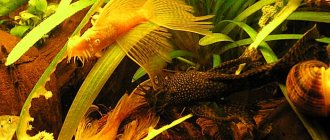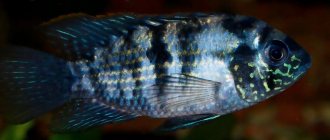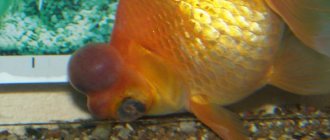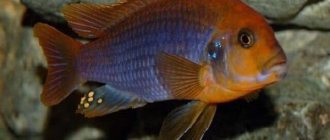Comet (Carassius gibelio forma auratus) Bloch 1782, one of the breeding forms of the aquarium goldfish, characterized by an elongated forked caudal fin resembling the tail of a comet.
Like other goldfish, it is a freshwater species from the carp family.
Comets are now the most common type of goldfish in the world. These are large fish, so they are best kept in open ponds or large aquariums.
What kind of fish is this and its types
A comet is one of the so-called goldfish. This breeding form has an elongated torpedo-shaped body, which makes it stand out among its fellows.
Comet fish has several varieties:
- Calico. Compared to other types of comets, it is very small in size - no more than 5 cm in length. She has a long tail and spotted coloring.
- Red. It is brightly colored scarlet and has a less luxurious tail than the calico comet.
- Black. This fish has a charcoal color and a double tail without a characteristic cutout.
- Yellow. This species can easily be confused with a goldfish, but the yellow comet has a different coloration. It lacks the famous golden hue for which the goldfish got its name. The yellow species has a long body and short fins.
Unpretentious comets can be kept in aquariums and artificial ponds with clean, oxygenated water.
Reviews
Comets are considered interesting fish to watch. Aquarists do not regret purchasing this elegant fish for their aquarium, because caring for them is simple and reproduction does not require special knowledge.
Appearance
The fish has an oblong body with a slightly raised back. The maximum length is 20 cm. Swelling is considered a fault of the breed, such individuals are not allowed to reproduce. The tail has a single fin with a large notch.
The tail is several times longer than the body. The larger it is, the more beautiful and interesting the fish. The tail blades are ribbon-shaped, and the fin on the back is quite high and without any curly cutouts.
There are specimens in which the fins on the back, chest and belly have a veil shape and look like long ribbons in the water. Such comets compete with veil tails in terms of the beauty of their fins.
Breeders have bred comet fish of different colors:
- silver;
- red and white;
- golden;
- calico and other colors.
The classic color is a combination of white and red. The most prized are individuals whose fins differ in color from their body. Among the most beautiful specimens are fish with lemon or silver bodies and bright red tails.
The brightness of the color of comet fish depends on the quality of water, lighting, filtration, feeding and other conditions of detention.
How to distinguish a male from a female?
In comets, males and females look different. They are easy to distinguish by a number of external signs.
Features of females:
- more active;
- larger;
- have a brighter color;
- sharp fins on the belly;
- The belly becomes rounded and swollen during spawning.
Features of males:
- have rounded and shorter fins on the belly;
- the harder area between the belly and anus;
- growth in the back of the abdomen;
- concave anal opening;
- During spawning, the body shape remains elongated and flattened, and white stripes appear near the gills.
Compatibility
The best option is to keep the species separately - you can have comets of different colors in the aquarium. Varieties of goldfish are good neighbors for them.
Comets get along well with peaceful fish that require similar conditions. Shubunkins (calicos) - decorative goldfish, ancistrus and corydoras (catfish) are suitable for them.
Unwanted neighbors:
- telescopes are a sedentary breed;
- angelfish and discus are heat-loving species;
- tetras and neons are small fish;
- barbs - love to bite the veiled fins of other fish.
Comets, moving rapidly through the aquarium, cause stress in slow-moving breeds. And small fish that fit in their mouth can easily be accidentally swallowed.
Habitat in nature
Like the goldfish, the comet is an artificially bred breed and is not found in nature.
According to the main version, it appeared in the USA. It was created by Hugo Mulertt, a government official, in the late 1880s. Comet was successfully introduced into Government Fish Commission ponds in Washington County.
Later, Mullert began to actively promote goldfish in the United States and wrote several books about keeping and breeding these fish. It was thanks to him that this fish became popular and widespread.
But there is also an alternative version. According to her, this fish was bred by the Japanese, and Mullert created the American type, which later became widespread. However, the Japanese themselves do not claim to be the creators of the breed.
Care and maintenance
Comets are easy to maintain and unpretentious. A responsible and caring aquarist will not have any problems with breeding them.
Aquarium
When choosing the volume of the aquarium, take into account the size and number of fish. One adult should have at least 50 liters of water, for a couple - 100 liters. Comets are active and mobile, so they need a large and spacious aquarium with a lid so that the fish do not jump out.
Water parameters
In order for fish to grow, develop and reproduce safely, they need to be provided not only with a spacious aquarium, but also with high-quality water. Comets have a number of strict requirements for it.
What should be the water in the aquarium:
- the optimal water temperature for habitat is +20...+24°C, but comets can easily tolerate lows and highs ranging from +18 to +30°C;
- recommended hardness — 6-16;
- acidity - 7 pH.
Comets are not very sensitive to chemical impurities, especially if their concentration is within normal limits.
Plants
Comets tend to dig up roots buried in the ground, so plants with strong roots should be planted in the aquarium. Or you can “plant” artificial plantings.
In an aquarium with comets it is recommended to plant:
- Vallisneria;
- egg capsule;
- Echinodorus;
- Anubias;
- alternantera;
- aponogeton.
Scenery
Decorating an aquarium is not necessary - it is a matter of taste for the aquarist. Decorations make it more attractive and aesthetically pleasing. In addition, the decorations act as shelters.
What can be used for decorations and shelters:
- natural driftwood and branches;
- pet store houses;
- stones of different colors and sizes.
There should be no sharp corners in aquarium decorations, since comets have delicate bodies that can easily be damaged by unevenness.
Priming
One of the favorite activities of comets is rummaging in the soil. And, if fine-grained soil is poured onto the bottom, the water in the aquarium becomes cloudy. To prevent turbidity from rising from the bottom, large pebbles, gravel, granite or basalt chips are used as soil.
The soil in the aquarium should not have fractions with sharp edges. Moving fish can get injured by them. The best option is coarse sand or pebbles.
Equipment
Comets are not particularly clean, so the owner of the aquarium must constantly keep it clean. Residues of the inhabitants’ vital activity and uneaten food should not float in the water.
Comet fish thrive in oxygenated water. To provide them with favorable living conditions, a compressor or other aeration unit is installed in the aquarium.
Lighting
Lighting plays an important role in the life of comets. The intensity of the light determines how bright and beautiful the fish will be. If there is little light, comets become pale and dull.
It is advisable to place the aquarium near windows where the sun shines for 10-12 hours. If there is a lack of natural lighting, artificial lighting is organized - special aquarium lamps are installed.
Diseases
Comets are considered relatively hardy fish. But if there are violations in care and feeding, certain diseases can develop:
- semolina: the body of the fish is covered with white dots that look like a scattering of semolina;
- fin rot: fins stick to each other, and representatives of the species themselves lose physical activity and begin to eat poorly;
- dermatomycosis: a characteristic white coating appears on the body of the fish;
- ascites: the disease is manifested by refusal to eat, characteristic bulging of the eyes and the appearance of lesions and ulcerative defects on the body of the fish.
Sick individuals refuse to eat. Specific medications must be used for treatment. They contain antibiotics and antifungal components. Infected fish must be placed in a special separate tank with high-quality aeration and filtration.
Ascites
The fish's scales become ruffled, its belly enlarges, and bulging eyes develop. Sores appear on the body, activity decreases. The disease is treatable only at the initial stage.
The fish is removed, 1 tsp is added to 40 liters of water. Epsom salt, which draws out excess liquid. Baths of a pale pink solution of potassium permanganate help. The sick comet is launched into the container for 10 minutes, then placed back into the depositor.
Ichthyophthiriasis
The fungal infection is also called semolina because of the white pustules resembling semolina scattered over the body and fins.
The disease is treated by gradually raising the temperature to 30°C, adding salt (1 tbsp per 10 liters of water). Comets are treated in a community aquarium with malachite green (0.1 mg per 1 l), iodine (10 drops per 50 l), furazolidone (150 mg per 50 l). The last drug is toxic to plants, be careful!
Fin rot
A serious illness that often ends in the death of the pet. A pale blue mucous coating covers the fins, then the infection spreads to the body, covering the fish's skin with ulcers. The comet is placed in a separate container. Along with the daily water change, Levomycetin (0.5 tablets per 10 l), Bicillin-5 (a tenth of a bottle per 10 l) or streptocide (15 g per 100 l) are added to the aquarium.
Feeding
Comets eat any food with great appetite. These omnivorous fish often overeat, so they need to be fed rationed - plant foods and balanced protein foods.
The fish's diet should contain live food:
- bloodworm;
- Artemia;
- cyclops;
- rotifers;
- daphnia;
- earthworms.
The fish are also given vegetable supplements - dandelions (leaves), lettuce, spinach, duckweed, cucumbers. But the main food is dry food for goldfish. Gluttonous comets can be fed with porridge - rice or buckwheat.
The following foods are recommended for feeding comets:
- Tetra Goldfish - one of the best lines for goldfish. Available in the form of chips, flakes, granules, sticks.
- TetraPro Algae - delicate food made using low-temperature technologies. Contains spirulina, which promotes normal functioning of the gastrointestinal tract. Increases immunity.
- TetraPro Energy — It is recommended to introduce it into the diet and alternate with other foods. It provides the fish with additional energy.
Comets are capable of eating food in any location - from the surface of the water, in its thickness, from the bottom. The fish are fed twice a day - in the mornings and evenings. It usually takes the fish 5 minutes to feed. Anything they haven't eaten must be removed within half an hour.
Comets are very voracious and prone to obesity, so they are fed strictly on a schedule. It is much healthier for these fish to starve than to overeat, since gluttony causes them to have digestive problems. The maximum time for a hunger strike without harming the health of the comets is 2 days.
Diseases
Improper care and feeding regimen, as well as infection, causes the following diseases in comets:
- Overfeeding. The main symptom of this condition is a severely swollen abdomen. At the first signs of the disease, the sick individual should be placed in a separate aquarium, ensuring the proper level of filtration and aeration. To eliminate the consequences of overfeeding, it is necessary to increase the water temperature in a separate aquarium and add a weak solution of potassium permanganate to it. Do not feed the goldfish for 3-4 days and change at least 10% of the water daily.
- Dropsy. Occurs either in case of water poisoning with chemicals, or due to crayfish distemper bacteria. With dropsy, the body of the comet swells, the scales rise, the eyeballs enlarge and the ridge becomes bent. To cope with dropsy, the sick individual is kept in running water for a long time and bathed daily in a weak solution of potassium permanganate.
- Scabies. The disease is caused by the decomposition of artificial food.
The first symptoms of scabies are that the fish itch their entire bodies against stones or decorative elements. To combat scabies, the comet is placed in a container with cool (no more than 18 degrees) and slightly salted water (20 g per liter) for 3 days. Salt water is changed every day. Learn the symptoms and treatments for goldfish diseases. - Changeling. The causes of this condition, in which there is a violation of the swim bladder, have not been established. Characteristic signs: loss of coordination of movements and freezing on the surface of the water or deep at the bottom. The skinwalker is treated as follows: the water level in a separate reservoir is lowered to 5 centimeters, the water is heated to +26 degrees, and enhanced aeration is provided. The comet is fed only with daphnia and bloodworms (not in dry form). It is prohibited to give granules and large flakes to fish. If all the rules are followed, the changeover goes away within 2–3 days.
Breeding comet fish can become an exciting hobby even for those who have never dealt with aquariums and their inhabitants, but want to see not just a simple, but a real goldfish in their aquarium. Proper care and careful treatment of this beauty guarantee her good health and long life.
Reproduction and spawning
Any beginning aquarist can cope with breeding comets. For this purpose you need a special aquarium for spawning. Its minimum volume is 30 liters. A net is placed at the bottom of the spawning aquarium, plants with small leaves are planted, filters and aeration devices are installed.
Manufacturers are selected from fish over two years old. Males become more active during the spawning period (spring). They chase females and cling to their ovipositors. In females, the abdomens are rounded due to the eggs. And males develop growths on their gills.
Features of comet reproduction:
- A female with 2-3 males is placed in a separate aquarium.
- The water temperature is increased to +28…+30°C.
- One female lays about 10,000 eggs.
- As soon as spawning is completed, the breeding males are removed from the spawning aquarium.
Comet fish are ideal residents of the home aquarium. They easily adapt to the proposed living conditions, are unpretentious, peaceful, attractive in appearance, and most importantly, very mobile - comets will appeal to those who prefer to watch the games and movements of fish in the aquarium.
Breeding
Prepare a separate tank - a spawning tank with a volume of 30-50 liters, where spawning and raising of fry will take place. Fill the spawning tank with soil and plant small-leaved plants. For breeding, a female and a pair of males over two years of age are selected and placed in a spawning tank. To stimulate comet spawning, the water in the tank is increased by a couple of degrees.
View this post on Instagram
Posted by comet goldfish? (@amazing_goldfish_love) Jan 5, 2018 at 9:28 am PST
Differences between a female and a male
To determine male or female, each sex has characteristics.











